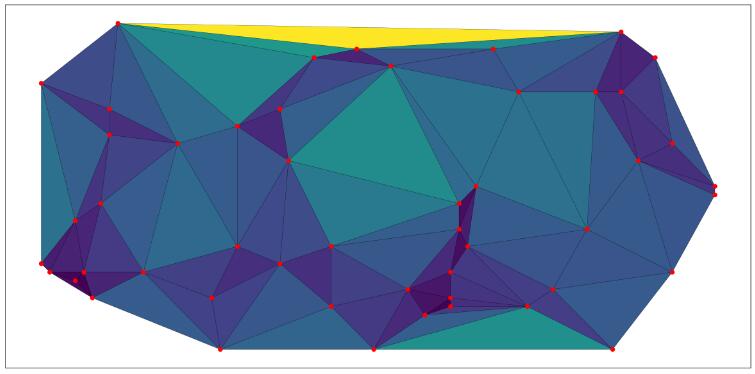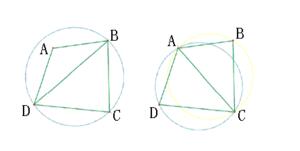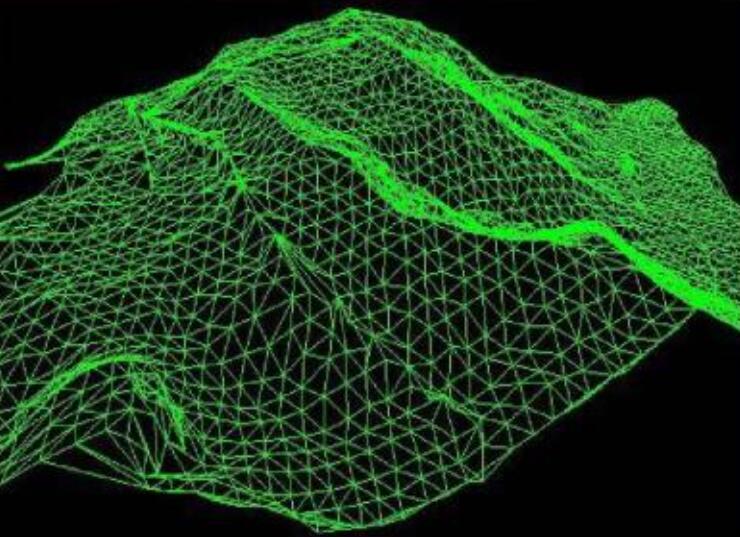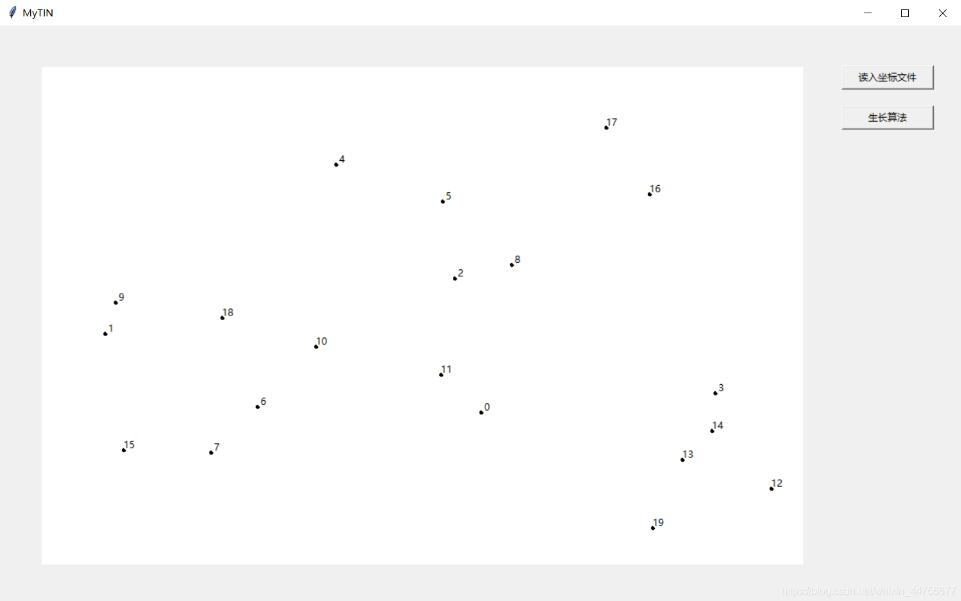python 實(shí)現(xiàn)德洛內(nèi)三角剖分的操作
我也不知道這玩意主要是干啥用的
實(shí)現(xiàn)如下我用剖分的三角形的三個(gè)頂點(diǎn)到中心點(diǎn)的距離和作為顏色, 結(jié)果顯示: 點(diǎn)越密集的地方, 圖片上的顏色越深。
from scipy.spatial import Delaunayimport numpy as npimport matplotlib.pyplot as pltwidth = 80height = 40 pointNumber = 50points = np.zeros((pointNumber, 2)) points[:, 0] = np.random.randint(0, width, pointNumber) points[:, 1] = np.random.randint(0, height, pointNumber)tri = Delaunay(points)center = np.sum(points[tri.simplices], axis=1)/3.0 ’’’color = []for sim in points[tri.simplices]: x1, y1 = sim[0][0], sim[0][1] x2, y2 = sim[1][0], sim[1][1] x3, y3 = sim[2][0], sim[2][1]s = ((x1-x2)**2+(y1-y2)**2)**0.5 + ((x1-x3)**2+(y1-y3)**2)**0.5 + ((x3-x2)**2+(y3-y2)**2)**0.5 color.append(s)color = np.array(color)’’’color = []for index, sim in enumerate(points[tri.simplices]): cx, cy = center[index][0], center[index][1] x1, y1 = sim[0][0], sim[0][1] x2, y2 = sim[1][0], sim[1][1] x3, y3 = sim[2][0], sim[2][1]s = ((x1-cx)**2+(y1-cy)**2)**0.5 + ((cx-x3)**2+(cy-y3)**2)**0.5 + ((cx-x2)**2+(cy-y2)**2)**0.5 color.append(s)color = np.array(color)plt.figure(figsize=(20, 10)) plt.tripcolor(points[:, 0], points[:, 1], tri.simplices.copy(), facecolors=color, edgecolors=’k’) plt.tick_params(labelbottom=’off’, labelleft=’off’, left=’off’, right=’off’, bottom=’off’, top=’off’) ax = plt.gca() plt.scatter(points[:,0],points[:,1], color=’r’)#plt.grid()plt.savefig(’Delaunay.png’, transparent=True, dpi=600)

補(bǔ)充:生長(zhǎng)算法實(shí)現(xiàn)點(diǎn)集的三角剖分( Python(Tkinter模塊))
關(guān)于三角剖分假設(shè)V是二維實(shí)數(shù)域上的有限點(diǎn)集,邊e是由點(diǎn)集中的點(diǎn)作為端點(diǎn)構(gòu)成的封閉線段, E為e的集合。那么該點(diǎn)集V的一個(gè)三角剖分T=(V,E)是一個(gè)平面圖G,該平面圖滿足條件:
1.除了端點(diǎn),平面圖中的邊不包含點(diǎn)集中的任何點(diǎn)。
2.沒(méi)有相交邊。
3.平面圖中所有的面都是三角面,且所有三角面的合集是散點(diǎn)集V的凸包。
在實(shí)際中運(yùn)用的最多的三角剖分是Delaunay三角剖分,它是一種特殊的三角剖分。
【定義】Delaunay邊:假設(shè)E中的一條邊e(兩個(gè)端點(diǎn)為a,b),e若滿足下列條件,則稱之為Delaunay邊:
存在一個(gè)圓經(jīng)過(guò)a,b兩點(diǎn),圓內(nèi)(注意是圓內(nèi),圓上最多三點(diǎn)共圓)不含點(diǎn)集V中任何其他的點(diǎn),這一特性又稱空?qǐng)A特性。
【定義】Delaunay三角剖分:如果點(diǎn)集V的一個(gè)三角剖分T只包含Delaunay邊,那么該三角剖分稱為Delaunay三角剖分。

關(guān)于Delaunay三角剖分算法可以參考百度百科Delaunay三角剖分算法
我做三角剖分的目的——構(gòu)建TIN,不規(guī)則三角網(wǎng)
不規(guī)則三角網(wǎng)(TIN)是DEM的重要形式之一,相較于規(guī)則格網(wǎng),其具有數(shù)據(jù)冗余小、細(xì)節(jié)丟失少的特點(diǎn)。
在分布不規(guī)則的高程點(diǎn)之間構(gòu)建出三角網(wǎng),其關(guān)鍵技術(shù)就是三角剖分

1、首先任選一點(diǎn),在點(diǎn)集中找出距離改點(diǎn)最近的點(diǎn)連成一條線,以該線為基線。
2、在所有點(diǎn)中尋找能與該基線構(gòu)成具有空?qǐng)A性三角形的點(diǎn),并構(gòu)成三角形。
3、以新生成的邊為基線,重復(fù)第二步,直至點(diǎn)集構(gòu)網(wǎng)完成。
具體代碼如下
所使用的python版本為python3.6,編輯器為Pycharm2018.3.1
#-*- coding:utf-8 -*-import tkinterfrom tkinter import filedialogimport csv#根據(jù)兩點(diǎn)坐標(biāo)計(jì)算距離def caldis(x1,y1,x2,y2): return ((x1-x2)**2+(y1-y2)**2)**0.5#輸入三角形三個(gè)頂點(diǎn),計(jì)算外接圓圓心及半徑def calcenter(x1,y1,x2,y2,x3,y3): y1=-y1 #計(jì)算公式是根據(jù)平面直角坐標(biāo)推算的,原點(diǎn)在左下角,但是計(jì)算機(jī)屏幕坐標(biāo)原點(diǎn)在右上角,所以計(jì)算式y(tǒng)坐標(biāo)取負(fù) y2=-y2 y3=-y3 if (y1 != y3 and y1 != y2 and y2 != y3): #判斷是否有y坐標(biāo)相等,即三角形某邊斜率為0的情況,避免出現(xiàn)墳分母為0的錯(cuò)誤if(((x3-x1)/(y3-y1))-((x2-x1)/(y2-y1)))==0: x2=x2+1x=(((y1+y3)/2)+((x1+x3)/2)*((x3-x1)/(y3-y1))-((y1+y2)/2)-((x1+x2)/2)*((x2-x1)/(y2-y1)))/(((x3-x1)/(y3-y1))-((x2-x1)/(y2-y1)))y=-((x3-x1)/(y3-y1))*x+((y1+y3)/2)+(((x1+x3)/2)*((x3-x1)/(y3-y1)))return (x, -y, caldis(x, y, x1, y1)) elif (y1 == y3 and y1 != y2 and y2 != y3):#若存在斜率為0的邊則計(jì)算可簡(jiǎn)化x=(x1+x3)/2y=-((x2-x1)/(y2-y1))*x+((y1+y2)/2)+((x2-x1)/(y2-y1))*((x1+x2)/2)return (x, -y, caldis(x, y, x1, y1)) #返回值為元組(圓心橫坐標(biāo)x,圓心縱坐標(biāo)y,外接圓半徑r),計(jì)算出來(lái)的y值要返回屏幕坐標(biāo)所以再次取負(fù) elif (y1 != y3 and y1 == y2 and y2 != y3):x = (x1 + x2) / 2y = -((x3 - x1) / (y3 - y1)) * x + ((y1 + y3) / 2) + ((x3 - x1) / (y3 - y1)) * ((x1 + x3) / 2)return (x, -y, caldis(x, y, x1, y1)) elif (y1 != y3 and y1 != y2 and y2 == y3):x = (x3 + x2) / 2y = -((x3 - x1) / (y3 - y1)) * x + ((y1 + y3) / 2) + ((x3 - x1) / (y3 - y1)) * ((x1 + x3) / 2)return (x, -y, caldis(x, y, x1, y1)) else:return Noneclass getTIN: #定義窗口及操作類 def __init__(self):self.path=str() #坐標(biāo)文件路徑self.pointlist=[] #存放所有點(diǎn)坐標(biāo)的列表self.linelist=[] #存放線的列表,每條線用兩個(gè)點(diǎn)號(hào)表示連線self.tk=tkinter.Tk() #定義主窗口self.tk.title(’MyTIN’)self.tk.geometry(’1200x720’)self.shengzhang=tkinter.Button(self.tk,text=’生長(zhǎng)算法’,width=15,command=self.drawTIN_shengzhang)self.shengzhang.place(x=1050,y=100) #定義按鈕,關(guān)聯(lián)到生長(zhǎng)算法計(jì)算TIN的的函數(shù)self.readin=tkinter.Button(self.tk,text=’讀入坐標(biāo)文件’,width=15,command=self.getfile)self.readin.place(x=1050,y=50)self.can=tkinter.Canvas(self.tk,width=950,height=620,bg=’white’)self.can.place(x=50,y=50)self.tk.mainloop() def getfile(self): #選擇坐標(biāo)文件(*.csv),從文件中讀入坐標(biāo)存入pointlist列表并在繪圖區(qū)展示出來(lái)self.path=filedialog.askopenfilename()f=open(self.path,’r’)fd=csv.reader(f)self.pointlist=list(fd)for i in range(0,len(self.pointlist)): self.can.create_oval(int(self.pointlist[i][0])-2,int(self.pointlist[i][1])-2,int(self.pointlist[i][0])+2,int(self.pointlist[i][1])+2,fill=’black’) self.can.create_text(int(self.pointlist[i][0])+7,int(self.pointlist[i][1])-7,text=str(i)) def drawTIN_shengzhang(self):j = 1k = 0mindis = ((int(self.pointlist[0][0]) - int(self.pointlist[1][0])) ** 2 + (int(self.pointlist[0][1]) - int(self.pointlist[1][1])) ** 2) ** 0.5x = len(self.pointlist)for i in range(1, x): dis = ((int(self.pointlist[0][0]) - int(self.pointlist[i][0])) ** 2 + (int(self.pointlist[0][1]) - int(self.pointlist[i][1])) ** 2) ** 0.5 if dis < mindis:mindis = disj = iself.linelist.append((k,j)) #首先計(jì)算出距起始點(diǎn)(點(diǎn)號(hào)為0)距離最短的點(diǎn),以這兩點(diǎn)的連線作為基線開始生長(zhǎng)self.shengzhangjixian(k,j) def drawTIN(self): #根據(jù)線文件在繪圖區(qū)繪制出TINfor i in self.linelist: self.can.create_line(self.pointlist[i[0]][0], self.pointlist[i[0]][1], self.pointlist[i[1]][0], self.pointlist[i[1]][1]) def shengzhangjixian(self,i,j): #根據(jù)某一基線開始生長(zhǎng)的函數(shù)x = len(self.pointlist)for k in range(0,x): #遍歷沒(méi)一個(gè)點(diǎn),判斷是否與基線構(gòu)成D三角形 n = 0 #n用于統(tǒng)計(jì)外接圓內(nèi)的點(diǎn)數(shù) if ((k,i) not in self.linelist) and ((i,k) not in self.linelist) and ((j,k) not in self.linelist) and ((k,j) not in self.linelist):for y in range(0,x): #遍歷每一個(gè)點(diǎn),判斷 if y==i or y==j or y==k:continue if(calcenter(int(self.pointlist[i][0]),int(self.pointlist[i][1]),int(self.pointlist[j][0]),int(self.pointlist[j][1]),int(self.pointlist[k][0]),int(self.pointlist[k][1]))==None):continue else:xyr=calcenter(int(self.pointlist[i][0]),int(self.pointlist[i][1]),int(self.pointlist[j][0]),int(self.pointlist[j][1]),int(self.pointlist[k][0]),int(self.pointlist[k][1])) if caldis(xyr[0],xyr[1],int(self.pointlist[y][0]),int(self.pointlist[y][1])) < xyr[2]: #判斷點(diǎn)是否在外接圓內(nèi)n=n+1 else:continue else:continue if n == 0: #判斷是否為D三角形self.linelist.append((k,i)) #將新生成的邊的端點(diǎn)號(hào)加入線列表self.drawTIN() #調(diào)用繪制函數(shù)繪制TINself.shengzhangjixian(k,i) #以生成的新邊作為基線,迭代計(jì)算self.linelist.append((k,j))self.drawTIN()self.shengzhangjixian(k,j) else:continueif __name__ == ’__main__’: MyTIN=getTIN()
通過(guò)如下代碼生成一組隨機(jī)的點(diǎn)并存入文件
import randomimport csvfrom tkinter import filedialogpath=filedialog.askopenfilename()OutAddress=open(path,’a’,newline=’’)csv_write = csv.writer(OutAddress,dialect=’excel’)for i in range(0,20): x=random.randint(30,920) y=random.randint(30,590) out=(x,y) print(out) csv_write.writerow(out)
通過(guò)上面的程序我們得到一組坐標(biāo)如下
550,43281,334517,265842,408369,123502,169271,425213,482588,24894,295344,350500,385912,527801,491838,455104,479760,160706,77227,314764,576
將以上的點(diǎn)在界面中展示出來(lái)

點(diǎn)擊生長(zhǎng)算法運(yùn)行得到結(jié)果

生長(zhǎng)算法在三角剖分算法中并不是什么高效的算法,其特點(diǎn)在于算法簡(jiǎn)單易行,但是計(jì)算量大,并且對(duì)于新插入的點(diǎn)無(wú)法更新,必須重新計(jì)算。
相比之下,逐點(diǎn)插入算法雖然計(jì)算量仍然較大(似乎三角剖分計(jì)算量都不小),但是能實(shí)現(xiàn)對(duì)新插入點(diǎn)的更新而不用重頭計(jì)算。
注:文中部分圖片及介紹來(lái)自百度百科。
以上為個(gè)人經(jīng)驗(yàn),希望能給大家一個(gè)參考,也希望大家多多支持好吧啦網(wǎng)。如有錯(cuò)誤或未考慮完全的地方,望不吝賜教。
相關(guān)文章:
1. 前端html+css實(shí)現(xiàn)動(dòng)態(tài)生日快樂(lè)代碼2. 不要在HTML中濫用div3. el-input無(wú)法輸入的問(wèn)題和表單驗(yàn)證失敗問(wèn)題解決4. CSS3實(shí)例分享之多重背景的實(shí)現(xiàn)(Multiple backgrounds)5. XML基本概念XPath、XSLT與XQuery函數(shù)介紹6. XML入門的常見問(wèn)題(四)7. WML的簡(jiǎn)單例子及編輯、測(cè)試方法第1/2頁(yè)8. vue實(shí)現(xiàn)復(fù)制文字復(fù)制圖片實(shí)例詳解9. 關(guān)于html嵌入xml數(shù)據(jù)島如何穿過(guò)樹形結(jié)構(gòu)關(guān)系的問(wèn)題10. XML入門的常見問(wèn)題(三)

 網(wǎng)公網(wǎng)安備
網(wǎng)公網(wǎng)安備